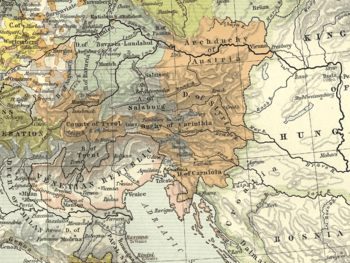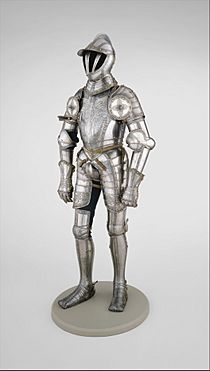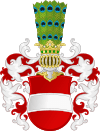Archduchy of Austria facts for kids
Quick facts for kids
Archduchy of Austria
Erzherzogtum Österreich (German)
|
|||||||||||
|---|---|---|---|---|---|---|---|---|---|---|---|
| 1453–1806 1867-1918 |
|||||||||||
|
Motto: Alles Erdreich ist Österreich untertan
"All the world is subject to Austria" |
|||||||||||

The Archduchy of Austria within the Habsburg hereditary lands (orange), 1477
|
|||||||||||
| Status | State of the Holy Roman Empire (1453–1806) Crown land of the Habsburg monarchy (from 1526) |
||||||||||
| Capital | Vienna | ||||||||||
| Common languages | Central Bavarian, German | ||||||||||
| Religion | Roman Catholic | ||||||||||
| Government | Archduchy | ||||||||||
| Archduke | |||||||||||
|
• 1453–1457
|
Ladislaus the Posthumous (first formal archduke) |
||||||||||
|
• 1792–1806
|
Francis I | ||||||||||
|
• 1916–1918
|
Charles I | ||||||||||
| Historical era | Early modern period | ||||||||||
|
• Duke Rudolf IV forged Privilegium Maius
|
1358/59 | ||||||||||
|
• Emperor Frederick III acknowledged archducal title
|
6 January 1453 | ||||||||||
|
• Joined Austrian Circle
|
1512 | ||||||||||
|
• Ferdinand I regent according to Worms agreement
|
28 April 1521 | ||||||||||
| 1740–1748 | |||||||||||
|
• Austrian Empire proclaimed
|
11 August 1804 | ||||||||||
|
• Holy Roman Empire dissolved
|
6 August 1806 | ||||||||||
| 30 August 1867 | |||||||||||
|
• Monarchy abolished
|
18 November 1918 | ||||||||||
|
• Disestablished
|
1918 | ||||||||||
| Currency |
|
||||||||||
| ISO 3166 code | AT | ||||||||||
|
|||||||||||
|
The title "Archduke of Austria" remained part of the official grand title of the rulers of Austria until 1918.
|
|||||||||||
The Archduchy of Austria (German: Erzherzogtum Österreich) was a very important state within the Holy Roman Empire. It was the main part of the Habsburg monarchy, a powerful family that ruled over many lands. Its capital city was Vienna, located in the southeastern part of the Empire.
The name "Austria" comes from an old Frankish word, Oustrich, meaning "Eastern Kingdom". This is because it was east of the Frankish kingdom. Austria started as a smaller area called the Margraviate of Austria. In 1156, it became the Duchy of Austria.
The House of Habsburg took control of Austria in 1282. In 1453, Emperor Frederick III, who was also the ruler of Austria, officially gave it the special title of "Archduchy". From the 1400s onwards, almost all Holy Roman Emperors were also Archdukes of Austria. The Habsburgs gained control of lands like Bohemia and Hungary in 1526. This made their lands the center of a major European power.
The Archduchy of Austria stopped being an independent state when the Holy Roman Empire ended in 1806. It then became two smaller regions, Lower and Upper Austria, within the new Austrian Empire.
Contents
Geography of the Archduchy

The Archduchy of Austria was located in the Danube river basin. This area was once an old Roman province called Pannonia Superior. To the east, Austria shared borders with the Kingdom of Hungary, separated by the March and Leitha rivers.
To the south, it bordered the Duchy of Styria, with the Semmering Pass as a natural boundary. In the north, the Bohemian Forest and the Thaya river formed the border with Bohemia and Moravia.
In the west, the part of Austria called Upper Austria bordered the Duchy of Bavaria. The nearby Innviertel region used to belong to Bavaria. However, Austrian forces took control of it during the War of the Bavarian Succession in 1778. It officially became part of Austria after the Peace of Teschen. Later, in 1803, the Austrian rulers also gained control over the Electorate of Salzburg and the Berchtesgaden Provostry.
History of Austria's Rise
Austria became a separate state in 1156, no longer part of Bavaria. The House of Babenberg dukes, who ruled Austria, also gained control of the nearby Duchy of Styria in 1192. After the Babenberg family died out in 1246, King Ottokar II of Bohemia took over. But the Habsburg king Rudolf I of Germany defeated Ottokar in 1278. Rudolf then gave Austria to his son, Albert I.
In 1358/59, the Habsburg duke Rudolf IV tried to make Austria even more important. He created a fake document called the Privilegium Maius. In this document, he claimed the special title of "Archduke". Rudolf wanted Austria to have a status similar to the seven prince-electors of the Empire, who had special voting rights. However, the Emperor Charles IV did not accept his claim. In 1379, Rudolf's family divided their lands. The Austrian duchy remained under the rule of the Albertinian line of the Habsburgs.
From Duchy to Archduchy
On January 6, 1453, Emperor Frederick III finally recognized the title of Archduke for Austria. Frederick was ruling Austria for his young cousin, Ladislaus the Posthumous. From then on, all Habsburg emperors and rulers, as well as other princes in the family, used the Archduke title. However, this title still did not give them the right to vote in the election of the Holy Roman Emperor.
Frederick III also helped the Habsburg family become even more powerful across Europe. He arranged for his son Maximilian I to marry Mary the Rich in 1477. Mary was the heir to the rich Duchy of Burgundy. Maximilian's son, Philip the Handsome, then married Joanna the Mad in 1496. Joanna was the Queen of Castile and the Crown of Aragon. Because of these marriages, Philip's son, Charles V, inherited a huge empire. People said it was an "empire on which the sun never sets" because it was so vast.
However, Charles V's younger brother, Ferdinand I, also had rights to some lands. In 1521, at the Diet of Worms, the lands were divided. Ferdinand became Archduke of Austria and ruler of nearby lands like Styria, Carinthia, Carniola, and Gorizia. In 1526, Ferdinand married Princess Anna of Bohemia and Hungary, which meant he inherited both the Kingdom of Bohemia and the Kingdom of Hungary.
Ferdinand I became King of the Romans in 1531. He was the founder of the Austrian branch of the Habsburg family. This branch, later called Habsburg-Lorraine from 1745, ruled as Archdukes of Austria and Kings of Bohemia. They also served as Holy Roman Emperors until the Empire ended in 1806.
The Austrian Empire is Formed
In 1804, Emperor Francis II of Habsburg was also the ruler of the Habsburg lands. He decided to combine his territories within the Holy Roman Empire with his Kingdom of Hungary. He created the Austrian Empire. He did this because Napoleon I had just declared himself Emperor of the French. Two years later, Francis officially ended the Holy Roman Empire.
The Archduchy of Austria continued to exist as a part of the new Austrian Empire. It was divided into Upper and Lower Austria for easier management. Hungary kept its special status as an independent kingdom within the empire. The title of Archduke continued to be used by members of the imperial family. The Archduchy was officially dissolved in 1918. This happened when Austria-Hungary collapsed after World War I. The separate states of Lower and Upper Austria were then created in the new Republic of German Austria.
See also
 In Spanish: Archiducado de Austria para niños
In Spanish: Archiducado de Austria para niños





